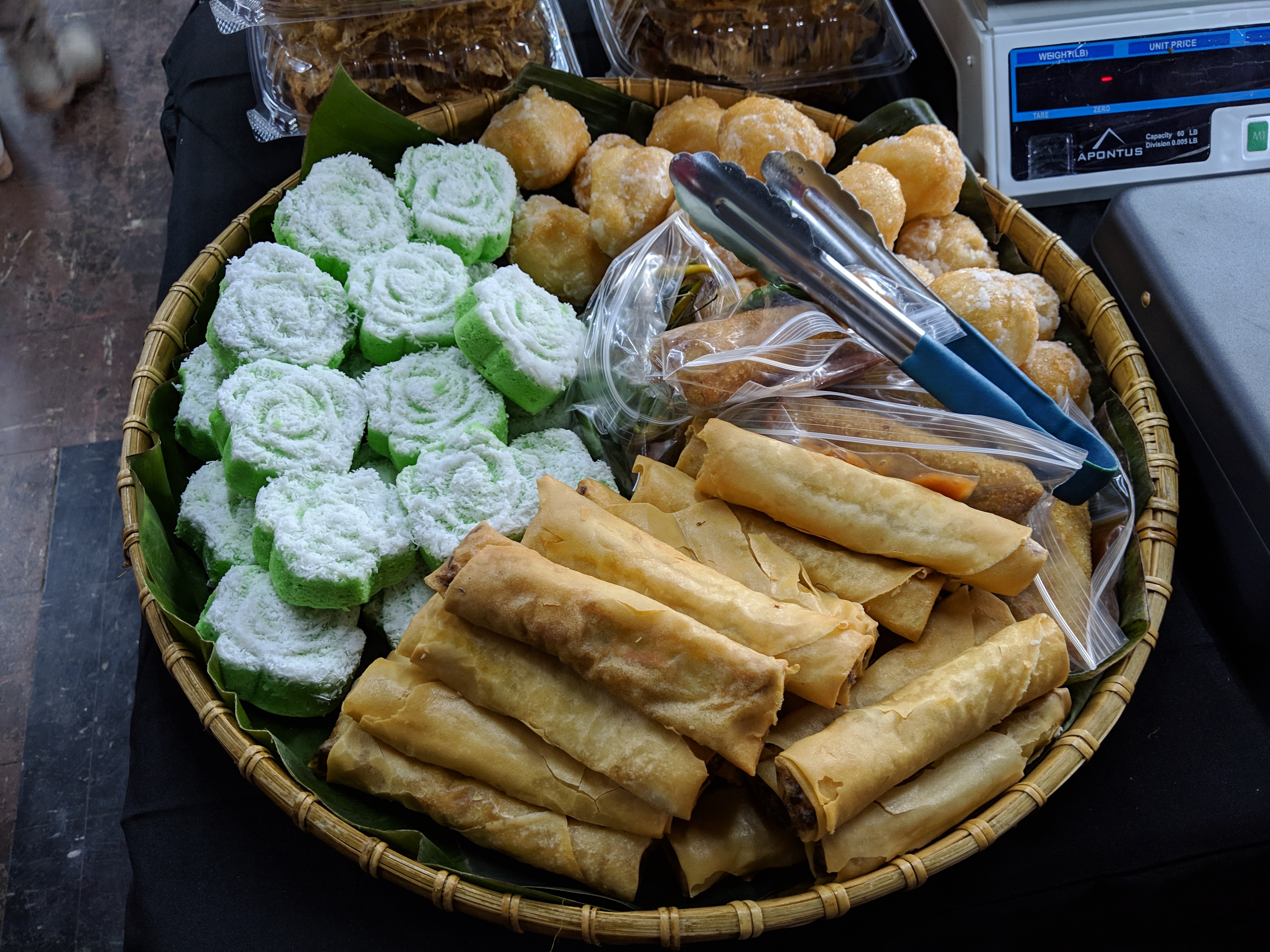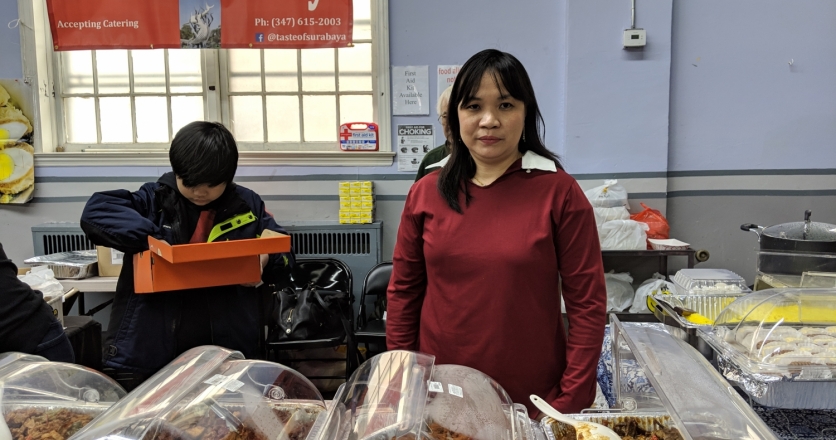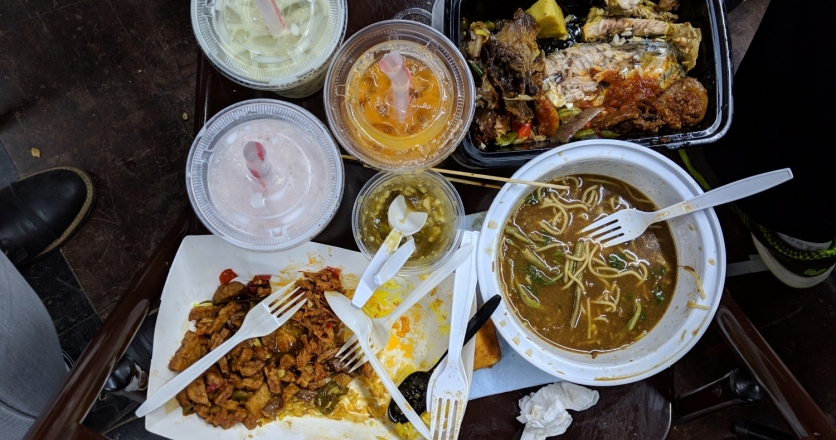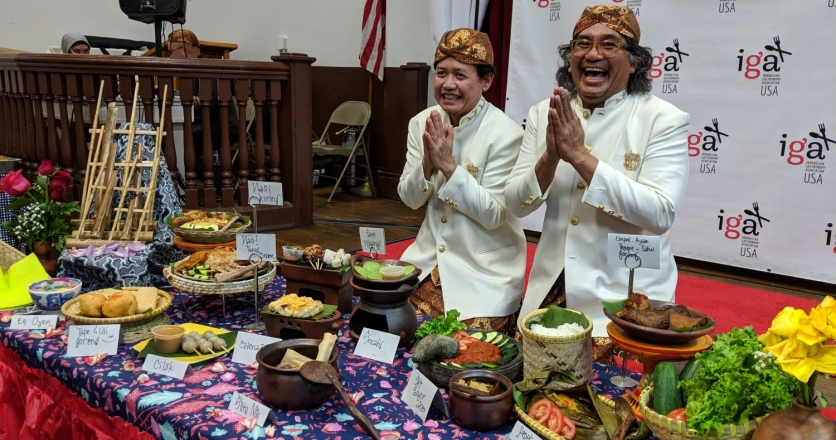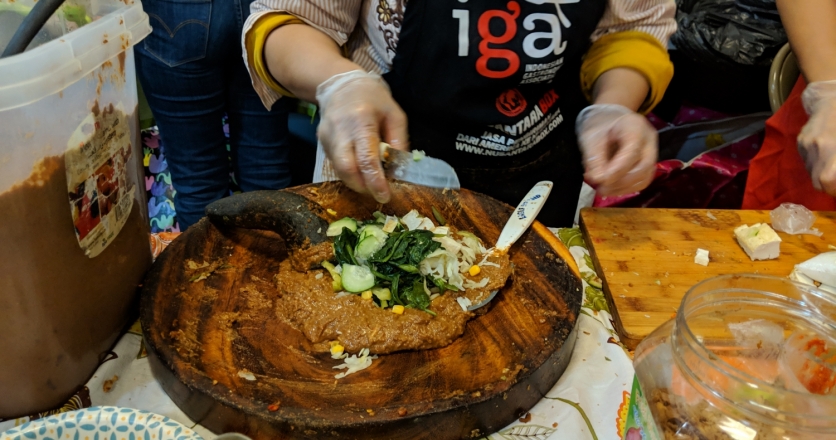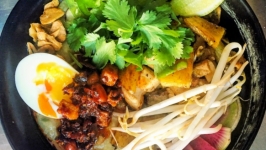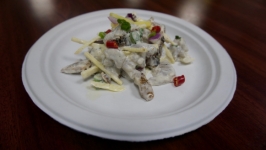Indonesian Gastrodiplomacy Takes Hold in Elmhurst
One brisk Saturday in late February, banners reading “Indonesian Food Bazaar” hung across the gates of St. James Episcopal Church in Elmhurst.
Inside, vendors with overflowing tins and food-cooking contraptions lined the walls. One stand run by a husband-wife team had an ice-shaving device, electric griddle and stations for frying noodles.
“We don’t have a restaurant,” said the husband, Andi Satanto. “We just do it because we love it.”
Another table had varieties of pempek, a pleasingly chewy fish cake—fried to order and topped with a spicy, sugary vinegar known as kuah cuka. Still others sold vegetable fritters, sweet drinks like es cendol and hot bowls of bakso, a meatball noodle soup.
In the far corner, the 44-year-old founder, Felincia Anggono—who goes by Fefe—was busy filling orders at her own booth, Taste of Surabaya, named after her Indonesian hometown. Her specialty is nasi kuning, a celebratory dish of bright yellow turmeric rice with assorted sides like charcoal-grilled chicken marinated with sweet soy sauce, steamed eggs and vegetables like fresh cucumbers or green chiles stir-fried with tempeh.
“A lot of people know Indonesia as Bali,” said Anggono, but “Indonesia is not only about Bali.”
A quick glance around the food bazaar gives a small idea of the diversity contained within one country, a diversity that’s still relatively unknown in much of the United States. Though Indonesia is the world’s fourth-most populous country, encompassing more than 17,000 islands, so far it’s maintained a lower profile in the United States than other Southeast Asian countries like Thailand, Vietnam and the Philippines.
Part of the reason could be the relatively small number of Indonesian immigrants in the United States. As of 2015, the community numbered around 113,000 across the country—around 1/44th of the Chinese immigrant population, which totaled nearly five million. However, the number of Indonesian residents has grown steadily since 2000. In terms of metropolitan areas, New York City is home to the third-largest Indonesian community (tied with Washington, DC). About 75% of those residents settle in Queens. Groups like the Indonesian Food Bazaar believe that now is the perfect time to bring attention to their culture.
“First, food is for your stomach, for your belly,” said Winanto Adi, minister counselor of Indonesia. “Then, food is for your thoughts.”
Over the years, Adi has helped promote the bazaar and served as an advisor. He’s also nudged the group towards more cultural offerings like film screenings, fashion shows and educational workshops. In February, the market featured a guest expert on tempeh—the soy product—which originated from Indonesia.
Since its start six years ago, the monthly Indonesian Food Bazaar has grown from a niche market to a bustling event, drawing food bloggers, adventurous eaters and visitors from all over the country.
The bazaar isn’t alone in its efforts. In the fall of 2018, another local group called the Indonesian Gastronomy Association started hosting their own culinary events with food vendors.
“Of the Asian community, we’re little known,” said Jonathan Wardhana, one of the association’s organizers. “So we thought it was time to put on our big boy pants and say, ‘Hey, we’re out here too.’”
One recent afternoon, 44-year-old Wardhana and two other members, Bertha Wulan and her husband, Ferry Lakburlawal, both in their 50s, gathered at Sky Café, a small Indonesian restaurant not far from St. James.
The three met while working with Anggono’s bazaar, but left after some disagreements over the vision. While IFB welcomed vendors from different cities, the Gastronomy Association felt that the focus should be on New York City sellers. Wardhana admitted that there was tension between the two groups at first, but since then, IGA has started to rethink their policies and have since opened the market to vendors from Philadelphia. They’ve also worked to differentiate themselves from the Bazaar.
Both monthly events use food as their lingua franca. But rather than covering multiple regions every time, the Indonesian Gastronomy Association aims to spotlight a different one each month. Their March event, for example, featured West Java, and the one before that focused on Jakarta.
Since they are newer, their markets have also been a little more chaotic. Not all of the vendors have signs, and the crowd is still relatively confined to the Indonesian community. However, the chaos also results in a more intimate event, like attending a family reunion. Last month, a few hours of karaoke followed a fashion show. The warblings of cheery, off-key singing beckoned passersby in from down the street.
“[Our goal is] more to introduce Indonesia by the food,” said Wulan. “Because we know that by the food, we can talk.”
The group pointed to a plate of chicken satay as an example. Satay shape-shifts by region across Indonesia, as barbecue does in the United States. There are tweaks in the type of meat used, the makeup of the marinade and even the taste of the dipping sauce. It’s nearly impossible to talk about one region’s satay without getting into the factors that have made it what it is.
Wardhana noted that the Chinese in the city have Chinatown, and the Korean population has K-town.
“Hopefully, maybe,” he said, “if we are successful not just as an idea but working with the Indonesian Food Bazaar, working with the community—maybe one day we do have that community, like Indonesian Village.” He gestured out the window. “Maybe this becomes the Indonesian Alley.”
Anggono also dreams of a more permanent space for the bazaar. She described a “house of Indonesia” complete with a food court, art gallery, apartments and a hotel. If Indonesian food is as well known as Chinese or Thai food one day, she’ll feel like their hard work has paid off.
For now, though, she’s happy spreading awareness through the bazaar, one plate of nasi kuning at a time.
Clarification: This story originally stated that the Indonesian Gastronomy Association had expanded to accept vendors from Philadelphia. The IGA is open to Indonesian vendors from all over the United States; it is not exclusive to New York City or Queens-based vendors.


